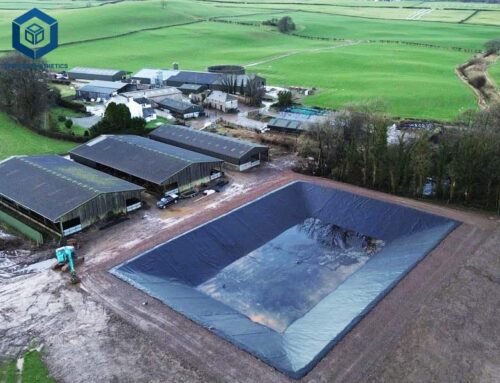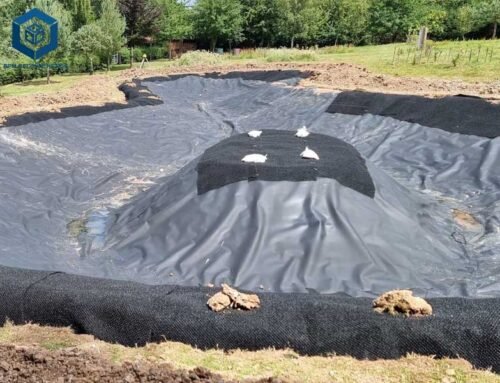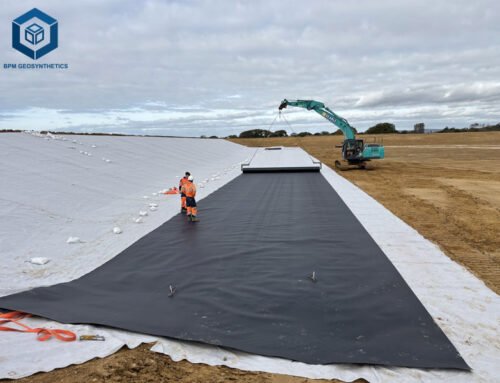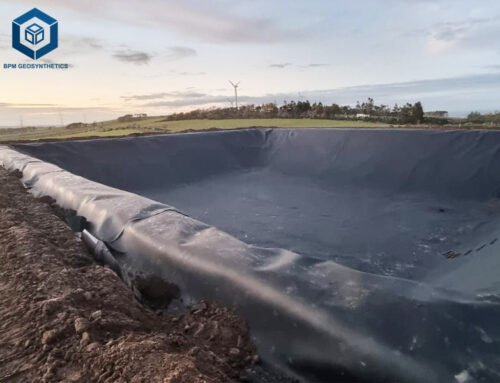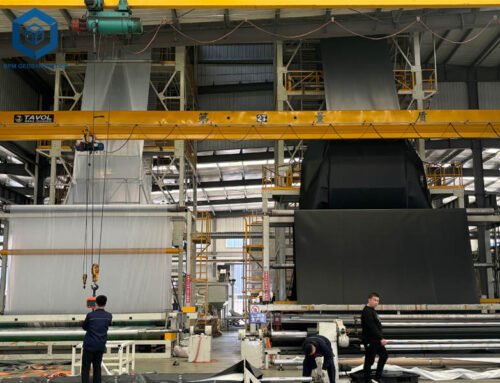HDPE geomembrane (high density polyethylene geomembrane) pond liners are made from high density polyethylene polymer material and are widely used for lining ponds, reservoirs, canals, wastewater treatment facilities, landfills, dams, lakes, fish ponds and many other areas due to their cost-effectiveness, chemical and weather resistance, and ability to prevent liquid leakage and gas volatilization. However, despite the many advantages of HDPE geomembrane pond liners, there are also some disadvantages.BPM geomembranes, known for their flexibility and excellent adhesive properties, may present a more cost-effective alternative while still providing robust protection against seepage.
1. What Are The Characteristics Of HDPE Geomembrane Pond Liner?
High-density polyethylene (HDPE) geomembranes are widely used as pond liners due to their exceptional characteristics. Here, we’ll delve into the key features that make HDPE geomembranes an ideal choice for various containment applications.
1.1 HDPE Geomembrane Pond Liner – Durability and Longevity
One of the standout characteristics of HDPE geomembranes is their durability. These liners are designed to withstand harsh environmental conditions, including exposure to UV radiation, extreme temperatures, and various chemicals. This resilience ensures a long service life, reducing the need for frequent replacements and maintenance. Additionally, HDPE geomembranes possess high tensile strength and puncture resistance, which helps maintain their integrity even under significant stress.
1.2 HDPE Geomembrane Pond Liner – Superior Impermeability
HDPE geomembranes offer excellent impermeability, making them highly effective at containing liquids. Their low permeability to water and other substances ensures that they can prevent seepage effectively. When properly welded, the seams between sheets of HDPE maintain this impermeability, creating a reliable barrier against leaks.
1.3 HDPE Geomembrane Pond Liner – Flexibility and Conformability
While HDPE geomembranes are robust, they also offer a good degree of flexibility. This allows them to conform to a variety of surface contours, although they may be less flexible than some alternatives like Butyl-Polypropylene (BPM) geomembranes. Proper installation techniques can help mitigate this limitation, ensuring the liner adheres well to irregular surfaces.
1.4 HDPE Geomembrane Pond Liner – Ease of Installation
The installation of HDPE geomembranes is relatively straightforward, thanks to their lightweight nature and the availability of heat welding techniques. These methods create strong, durable seams that enhance the overall integrity of the liner system. The ease of joining and handling makes HDPE geomembranes a practical choice for many projects.
1.5 HDPE Geomembrane Pond Liner – Cost-Effectiveness
Although the initial cost of HDPE geomembranes may be higher compared to some other materials, their long-term benefits often justify the investment. Their durability and low maintenance requirements contribute to a longer service life, potentially reducing long-term costs. This makes HDPE geomembranes a cost-effective solution over time.
1.6 HDPE Geomembrane Pond Liner – Environmental Considerations
HDPE geomembranes are non-toxic and safe for use in contact with drinking water and other sensitive environments. They are also recyclable, contributing to sustainable practices. Their non-biodegradable nature, while a potential environmental concern, is mitigated by their long service life and recyclability.


2. What Are Disadvantages Of HDPE Geomembrane Pond Liner?
While high-density polyethylene (HDPE) geomembranes are widely used as pond liners due to their excellent impermeability and durability, they do have some disadvantages. Here are the key drawbacks:
2.1 Limited Flexibility
Difficulty in Conforming to Irregular Surfaces: This can make installation challenging, especially on rough or uneven surfaces. The material’s rigidity requires careful handling during installation to avoid damage.
Environmental Degradation
2.2 Thermal and Oxidative Degradation
Prolonged exposure to environmental conditions can lead to thermal and oxidative degradation of HDPE geomembranes. This degradation changes the polymer’s morphological structure and properties, potentially compromising its long-term performance.
In conclusion, while HDPE geomembranes offer numerous benefits for pond liners, these disadvantages should be considered when choosing the right material for your specific application.
3. What Projects Are HDPE Geomembrane Pond Liner Suitable For?
High-density polyethylene (HDPE) geomembranes are extensively used in various industrial projects due to their excellent impermeability, durability, and flexibility. Here are some key applications:
3.1 Wastewater Treatment Plants
In wastewater treatment plants, HDPE geomembranes serve as reliable liners for containment basins, lagoons, and landfills. Their impermeability ensures that harmful contaminants do not leach into the groundwater, protecting environmental health and complying with stringent regulatory standards.
3.2 Mining Operations
Mining sites often use HDPE geomembranes to line tailings storage facilities and process water ponds. These liners prevent the seepage of toxic mine effluents into surrounding ecosystems, thereby mitigating environmental pollution and preserving natural habitats.
3.3 Industrial Storage Facilities
For industries dealing with hazardous or non-hazardous liquids, HDPE geomembranes provide a robust solution for secondary containment. These liners act as a fail-safe barrier, preventing spills and leaks from reaching the environment and ensuring compliance with safety regulations.
3.4 Agricultural Reservoirs
In agriculture, HDPE geomembranes are used to line reservoirs and irrigation canals. Their ability to prevent water loss through seepage makes them ideal for managing water resources efficiently, especially in arid regions.
3.5 Aquaculture Ponds
HDPE geomembranes are also suitable for lining fish farms and aquaculture ponds. They create a controlled environment that mimics natural habitats, promoting healthier fish growth and reducing the risk of water contamination.
In conclusion, HDPE geomembranes are versatile and effective solutions for a wide range of industrial projects. Their unique combination of impermeability, durability, and ease of installation makes them indispensable in modern engineering and environmental management practices.


4. How To Choose Suitable HDPE Geomembrane Pond Liner?
Choosing the right high-density polyethylene (HDPE) geomembrane pond liner is crucial for ensuring the success and longevity of various industrial projects. Here are key factors to consider when selecting an HDPE geomembrane pond liner:
4.1 Project Requirements
First, identify the specific use of your pond liner, as different industries have varying needs. For wastewater treatment plants, the liner must resist harsh chemicals and prevent leaks effectively. Similarly, mining operations require durable liners that withstand heavy loads and punctures. Meanwhile, agricultural reservoirs need flexible, UV-resistant liners to handle weather changes. Additionally, aquaculture projects demand non-toxic materials to protect aquatic life. Moreover, landfill sites rely on high impermeability to contain contaminants. Finally, always consider environmental factors like soil type and temperature. By matching the liner to your application, you ensure long-term performance and cost savings.
4.2 Material Quality
When choosing a pond liner, always consider the thickness to match your project’s needs. Thicker liners provide greater durability and puncture resistance, making them ideal for heavy-duty applications like landfills or mining. However, they can be more difficult to install due to their rigidity and weight. On the other hand, thinner liners are easier to handle but may require additional protection in harsh environments. Additionally, verify that the HDPE geomembrane meets recognized industry standards, such as ASTM or GRI-GM13, to ensure long-term reliability. These certifications confirm resistance to UV exposure, chemical degradation, and extreme temperatures. By balancing thickness with quality standards, you optimize both performance and cost-efficiency for your project.
4.3 Environmental Conditions
When selecting a pond liner, assess your local climate and temperature variations carefully. While HDPE geomembranes perform reliably in most conditions, extreme heat or cold may require stabilized formulations to maintain flexibility. In regions with intense sunlight, UV-resistant additives help prevent premature aging. Similarly, consider potential chemical exposure from industrial processes or agricultural runoff. Choose a liner specifically formulated to resist these chemicals, as some substances can degrade standard materials over time. For wastewater applications, verify the liner’s resistance to acids, alkalis and hydrocarbons. Manufacturers often provide chemical compatibility charts to guide your selection. By accounting for both environmental and chemical factors, you ensure optimal liner performance throughout its service life.
4.4 Installation and Maintenance
When selecting a geomembrane liner, prioritize installation ease, particularly for irregular surfaces or complex layouts. Some manufacturers offer pre-fabricated panels with factory-welded seams that significantly reduce field installation time. Flexible materials adapt better to uneven terrain while still maintaining their protective qualities. After installation, consider how easily you can access and inspect the liner for potential issues. Opt for materials that allow simple patching or welding repairs when needed. Regular inspection points and clean access routes make maintenance more efficient over time. By choosing a system that balances installation simplicity with maintainability, you’ll minimize both initial labor costs and long-term operational expenses.
4.5 Cost and Budget
When evaluating pond liner options, remember that HDPE geomembranes often prove more economical despite higher initial costs. Their extended lifespan and minimal maintenance needs typically offset the upfront investment within a few years. Always factor in professional installation costs when budgeting, as proper deployment significantly impacts performance. Additionally, include protective measures like geotextile underlayment in your financial planning to prevent punctures. While cheaper alternatives might seem attractive initially, they frequently require more frequent replacements and repairs. Consider the total cost of ownership rather than just purchase price when making your selection. By taking this comprehensive approach, you’ll ensure reliable containment and maximize your return on investment over the liner’s service life.
5. Summary
Despite the numerous advantages of HDPE geomembrane pond liners, they are not without their drawbacks. One significant disadvantage is their susceptibility to environmental stress cracking when exposed to harsh conditions for prolonged periods.Additionally, the installation process requires meticulous attention to detail to ensure that seams are properly welded and the liner is free from punctures or tears.
Furthermore, while HDPE is highly resistant to a wide range of chemicals, it is not impervious to all substances.This limitation must be carefully considered when selecting an HDPE geomembrane for specific applications, particularly in industrial settings where exposure to aggressive chemicals is likely.
In conclusion, while HDPE geomembrane pond liners offer several benefits, including durability and chemical resistance, they also have notable disadvantages. BPM companies must weigh these pros and cons carefully when deciding whether to use HDPE geomembranes in their projects. It is essential to consider factors such as environmental conditions, chemical exposure, and the importance of proper installation to mitigate the risks associated with this material.

